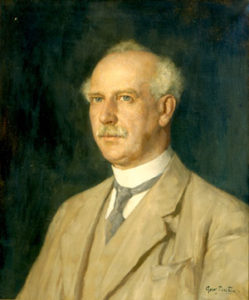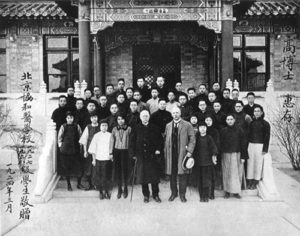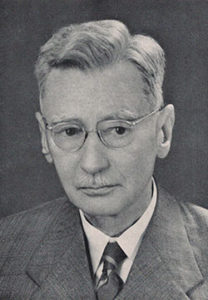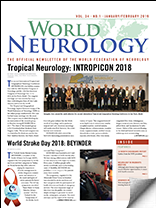by Peter J. Koehler
In this column on the history of international relationships in neuroscience (avant la lettre), the Rockefeller Foundation should have an important place, as it is associated with the foundation of so many neuroscientific institutions (for instance the Montreal Neurological Institute, 1934, and the Nieuw Leeuwenbergh, later named Brain Center Rudolf Magnus, in Utrecht, Netherlands, 1927) and research fellowships for so many international neuroscience students.
The Rockefeller Foundation was founded in 1913 and its mission has been (and still is) “to promote the well-being of humanity throughout the world.” For this essay, I selected one aspect, notably the Dutch-Chinese relationship, and more in particular the work of neuroanatomist Cornelis Ubbo Ariëns Kappers (1877-1946) and neurologist Ernst de Vries (1883-1976) in Beijing.
Ariëns Kappers

C.U. Ariëns Kappers
C.U. Ariëns Kappers worked under anatomist Louis Bolk (1866-1930) and the father of Dutch neurology, Cornelis Winkler (1855-1941) in Amsterdam. By the connections of the latter, he was able to start building an international network by working at the Dutch desk of the Zoological Station at Napoli, Italy (that opened in 1874 following ideas of zoologist Anton Dorhn (1840-1909), its first director), where he met Hungarian neurohistologist Stefan von Apàthy and neurophysiologist Jakob von Uexküll. He also visited the anthropological criminologist Cesare Lombroso (1835-1909) in Torino, Italy. Following the publication of his PhD thesis, he was invited by the German comparative neuroanatomist Ludwig Edinger (1855-1918) to work at the Senckenbergisches Institut in Frankfurt am Main, Germany. Here he worked on the concept of neurobiotaxis.
In 1909, Ariëns Kappers became director of the new Amsterdam Central Institute for Brain Research that was built following the call of the International Brain Commission to establish such institutes in various countries.1 Later, he published a three-volume book on comparative neuroanatomy, which was translated into various languages.2,3 At the Amsterdam Institute, he received approximately 70 colleagues from all over the world to do research. He received doctorates honoris causa from several universities (including Yale, Glasgow, and Chicago).
Next to the subject of neurobiotaxis, Ariëns Kappers’ two other research interests were the folding of cerebellar and cerebral cortex and craniometry. For the latter subject, he collected hundreds of skulls during his many voyages abroad.4 One of these voyages was to Beijing (1923-1924).
Beijing Union Medical College and the Rockefeller Foundation

Ariëns Kappers in front of the Beijing Union Medical College.
The college had been founded in Lockhart Hall, Beijing, in 1906 by several cooperating missionary organizations (a union of three British and three American societies) and was supported by the Empress Dowager. The Beijing Union Medical College included a men’s (60 beds) hospital, a women’s (30 beds) hospital, and an outpatient department. Following the establishment of the Rockefeller Foundation in 1913 and its China Medical Board to implement a program of medicine in China, Beijing Union Medical College received important financial support. At the time, there were 24 medical schools in China and 244 missionary hospitals with 446 foreign staff physicians.
John D. Rockefeller (1839-1937), a Baptist, already made modest gifts to religious and missionary programs in the 19th century. In fact, it was the first major program of the Rockefeller Foundation. The Beijing Union Medical College was to be organized after the model of Johns Hopkins Medical School and advice was given by William Welch (1850-1934) and Simon Flexner (1863-1946), who already played a role in the Rockefeller Institute for the advancement of medical research that had opened in 1902. They visited Beijing in 1915.
The Preparatory Department, employing several Americans, opened in 1917 and had eight premedical students. Two years later, the first seven medical students entered Beijing Union Medical College. Among the faculty members was William G. Lennox (1884-1960), who later returned to Harvard, where he worked in the field of epilepsy.
In 1919, philosopher-educator John Dewey (1859-1952) noted that “the Rockefeller buildings are lovely samples of what money can do. In the midst of this weak and worn city, they stand out like illuminating monuments of the splendor of the past in proper combination with the modern idea.”
Bertrand Russell (1872-1970), who visited Beijing in 1920, was more critical about the endeavor. “Although the educational work of the Americans in China is on the whole admirable, nothing directed by foreigners can adequately satisfy the needs of the country…” He later wrote that he had been saved by the “serum that killed the pneumococci” when he developed pneumonia during his visit to Beijing.
Beijing Union Medical College attracted the best medical students in China and several talented young American physicians taught here. The same is true with respect to visiting professors, including physiologists Walter B. Cannon (1871-1945) and Anton J. Carlson (1875-1956).5,6
At first, the neurology department was a part of the department of medicine, but in 1923, it became a separate department, headed by Professor Andrew H. Woods (1872-1956), who had been in China before and lectured neurology at the Pennsylvania Medical School in Philadelphia. He started working at the Beijing Union Medical College hospital in 1920.7
Ariëns Kappers in Bejing
Ariëns Kappers left the Netherlands in August 1923 after being invited by European representative of the Rockefeller Foundation Richard M. Pearce (1874-1930) to give a course of lectures in anatomy at the Beijing Union Medical College. With the intention of teaching brain anatomy, he shipped 50 “well-wrapped up brains” from the Amsterdam Wilhelmina Hospital to China. Moreover, he was expected to teach histology. For this purpose, he used the time sailing from Marseille to Shanghai to refresh his knowledge.
At the time, the Beijing Union Medical College had about 1,000 coworkers, including teachers, assistants, administrators, and servants. Ariëns Kappers’ name there was Kao (from his name) – Tai-Fu (great teacher/professor).8 In February 1924, he gave his last lecture in Beijing and made a voyage to several parts of China, including Changsha (Hunan), where he gave a series of 13 lectures (three on philosophical subjects).
Upon his return, he visited Manchuria (in particular its capital Shenyang formerly known as Mukden), Korea, Japan (visiting Okayama, Sendai, and Tokyo that had been stricken by an earthquake), collecting the brain of a whale and brains of Japanese for the Amsterdam Institute. He continued his voyage to the United States, where he lectured in several cities. In Chicago, he met his colleague, neuroanatomist Charles Judson Herrick (1868-1960). In New York, he gave a series of eight lectures at Columbia University and met John D. Rockefeller Jr. (1874-1960) as well as Simon Flexner, who at the time was working on poliomyelitis.
Ariëns Kappers served as visiting professor 1929-1930 at the American University in Beirut (that opened in 1866 following endeavors by the American missionaries at Lebanon and Syria since 1862). De Vries replaced him as director of the Institute in Amsterdam. Ariëns Kappers gave a series of lectures at the American University in Beirut, using the opportunity to collect craniometric anthropological data from Phoenician, Arab, and Jewish skulls in Syria, Turkey, and Palestine.
Only recently (November 2018) Ariëns Kappers posthumously received the Yad Vashem medal for the application of his anthropological work during the German occupation, saving at least 300 Jews from deportation.9
De Vries at the neurology department of the Beijing Union Medical College (1925-1932)
Whereas Ariëns Kappers stayed in Beijing only for about half a year, Dutch neurologist Ernst de Vries stayed there for several years (1925-1932). He was born the son of Dutch botanist Hugo de Vries (1848-1935), who independently rediscovered Gregor Mendel’s laws of heredity in the 1890s, introduced the term “mutation,” and published his two-volume Mutation Theory between 1900-1903. Following his MD, he worked with Constantin von Monakow (1853-1930) in Zurich and from 1910 at the Central Institute of Brain Research in Amsterdam as well as in the Amsterdam Clinic of Winkler. After working as physician in Leiden until 1925, he was called to become neuropsychiatrist at the Beijing Union Medical College, where he became associate professor in 1927. His work and that of his colleagues at the Beijing Union Medical College can be followed in the BUMC Annual Reports. As mentioned above, a separate neurology department was established in 1923, headed by Andrew H. Woods. German neuropsychiatrist Maximilian Otto Pfister (1874-?) was associate (professor) and acting head of the department. They had two residents. Apparently, Beijing was not spared from the encephalitis lethargica pandemica.10 In the 1925 report, for instance, it is written that “We have had an unusually large number of cases of extra-ocular and intra-ocular motor palsies which we concluded were caused by encephalitis epidemica.” Furthermore, psychiatric patients were sometimes seen at the asylum that was run by the local police. The 1925 report mentioned “the lack of accommodation for mental cases was keenly felt, for the treatment with malaria and relapsing fever in a few cases of general paralysis had encouraged further practice along this line.” Indeed, at the time, GPI (general paralysis of the insane) patients were treated with malaria to create a number of relapsing fever periods. The discoverer of the treatment, Julius Wagner von Jauregg (1857-1940), received the Nobel Prize in 1927.11 Other types of neurosyphilis were observed at the outpatient department. “As was the case last year, the number of cases of neurosyphilis was remarkably large, especially the cases of acute basal meningitis with involvement of the VIIth and VlIIth nerves.” Third-year medical students received “instruction in clinical neurology and neuropathology…. Ample opportunity was given to third-year students to practice the technique of lumbar puncture.”12 Apparently, De Vries replaced Pfister as associate under Woods. From the 1927 report we learn that “Dr. de Vries has supervised the laboratory work of the department, and has studied and made reports upon all of the brains, spinal cords, and other nervous tissues removed in autopsies by the Department of Pathology and in the various operating rooms.”

E. de Vries
To get an impression of the neurological diagnoses that were made, I mention the list from the report of that year: GPI, meningitis, myelitis, neuralgia, tuberculosis, tabes, beriberi (“usually in Chinese coming from the south and live here on a diet”),13 epilepsy, vascular disease, trauma, neuritis, psychoneurosis, and neurasthenia. An interesting sentence by De Vries in a Dutch publication on the Beijing Union Medical College is the following: “Patients are admitted only as long as they are of interest for educational or scientific purposes. Foreigners as well as a part of the Chinese population of Peking are aware of this, and many of them prefer to go to the German or French hospital, instead of being used as study material at the Beijing Union Medical College.” However, they added that if much laboratory work for diagnosis is necessary the Medical College is much better equipped resulting in choosing it by many. During the time of his appointment, there were 73 physicians, 33 professors or associates.13
When Woods left Beijing in 1928, the neurology department became a part of the Department of Medicine again. It consisted of four services, including General Medicine (51 beds), Pediatrics (16 beds), Dermatology and Syphilis (5 beds), and Neurology and Psychiatry (9 beds).14 De Vries became associate professor taking care of the neurological and psychiatric patients. Looking at the statistics of the 1930 report, it is remarkable that the highest number of admitted patients had psychiatric diagnoses, including hysteria, neurasthenia, and “neurosis of the stomach.” At the outpatient clinic, diagnoses made most often included idiopathic epilepsy, hysteria, neurasthenia, neuritis of the facial nerve, and tabes dorsalis. During De Vries’ absence on leave, he was replaced by Georg Schaltenbrand (1897-1979), who performed unethical experiments during the Nazi period.15 Upon his return in 1931 he was assisted by Yu Lin Wei, who became associate professor of neurology and psychiatry. Neurosurgery was done by S.T. Kwan, who “has spent the past two years at the clinic of Dr. Charles H. Frazier in Philadelphia. This is the first time the department has had a trained surgeon with full time to devote to this particular subject, and it is confidently expected that under Dr. Kwan’s direction there will be developed the first major neuro-surgical clinic in China.” Having worked with Frazier (1870-1936), it is of no surprise that he treated trigeminal neuralgia, but he also treated other afflictions of the nervous system. “In the past six months, there has already been a very satisfactory increase in the number of cases of trigeminal neuralgia, brain tumor … Peripheral nerve injuries, the result of gunshot wounds or other war injuries, are always abundant and will continue to be so until a less chaotic political condition prevails throughout the land.”16
During his stay at the Beijing Union Medical College, he published clinical cases (including a paper on post-vaccinial encephalitis in the China Medical Journal in 1928) but was mainly interested in circulation disorders of the brain (publishing in the Arch Neurol Psychiatry in 1931).17
In 1932, De Vries settled in Soerabaja (in the present Indonesia), where he practiced neurology until he was taken prisoner by the Japanese during World War II in 1943. Upon his return to the Netherlands in 1949, he worked as neuropathologist in Utrecht.
Rockefeller Foundation support in neuroscience projects
The Rockefeller Foundation interest in neurology increased in the 1930s when psychiatry “embracing neurology and psychology” became an important field of interest. Departments of psychiatry, but also of neurology and neurosurgery (including the Montreal Neurologic Institute mentioned above), were supported financially. Furthermore, “the Foundation maintained a steady stream of fellowships for advanced training in psychiatry, neurology, neurosurgery and related subjects… This type of support was by no means confined to the United States and Canada. The foundation aided significant research activities in Great Britain, France, Holland, Belgium, Germany, Sweden, Norway, and Switzerland.”, 18 p.130-1 This included the National Hospital for Diseases of the Nervous System at Queen Square (London), Otfrid Foerster’s Institute of Neurological Research in Breslau (1934), the Rudolf Magnus’ Physiological Institute in Utrecht (mentioned above, 1927). The stream of refugee neuroscientists from Germany was helped by the Rockefeller Foundation only in a limited degree between 1933 and 1940, but this improved after 1940.19 •
References
- Richter J. The brain commission of the international association of academies: the first international society of neurosciences. Brain Res Bull 2000; 52: 445–457.
- Ariëns Kappers CU, Droogleever Fortuyn AeB. Die Vergleichende Anatomie des Nervensystems. 3 Vols, Haarlem, De Erven F.Bohn (1920/1921).
- Ariëns Kappers CU, Crosby EC, Huber CG. The Comparative Anatomy of the Nervous System of Vertebrates including Man. 2 Vols. New York, MacMillan (1936). (3 Vols 2nd edit. New York, Hafner Publ. 1960; 3rd edit. 1967).
- Keyser A, Bruyn GW. C.U. Ariëns Kappers (1877-1946). In: Frederiks JAM, Bruyn GW, Eling P. History of Neurology in the Netherlands. Amsterdam, Boom, 2002, pp.269-81.
- Bowers JZ. The founding of Beijing Union Medical College: policies and personalities. Bull Hist Med 1971;45:305-21.
- Bowers JZ. The founding of Beijing Union Medical College: policies and personalities (concluded). Bull Hist Med 1971;45:409-29.
- Cheng Z. Andrew H. Woods in China and the United States: A medical history study at the Rockefeller Archives Center. Rockefeller Archives Center Research Reports, 2018.
- Ariëns Kappers CU. [Traveller in brains. Memories of a brain researcher] in Dutch; ed. Van Kolfschooten F. Amsterdam/Antwerpen, Veen, 2001.
- Zeidman LA, Cohen J. Walking a fine scientific line: the extraordinary deeds of Dutch neuroscientist C. U. Ariëns Kappers before and during World War II. J Hist Neurosci. 2014;23:252-75.
- Lutters B, Foley P, Koehler PJ. The centennial lesson of encephalitis lethargica. Neurology. 2018;90:563-67.
- Daey Ouwens IM, Lens CE, Fiolet ATL, Ott A, Koehler PJ, Kager PA, Verhoeven WMA Malaria Fever Therapy for General Paralysis of the Insane: A Historical Cohort Study. Eur Neurol. 2017;78:56-62.
- Annual Report of the Beijing Union Medical College, 1925, p. 61.
- De Vries E. [The hospital of the Peking Union Medical College] in Dutch. Ned Tijdschr Geneeskd 1926;70:1904-10.
- Annual Report of the Beijing Union Medical College, 1930, p.31.
- Zeidman LA Neuroscience in Nazi Europe part I: eugenics, human experimentation, and mass murder. Can J Neurol Sci. 2011;38:696-703.
- Annual Report of the Beijing Union Medical College, 1931, p.33.
- Droogleever Fortuyn AB, Van Rossum A. Ernst de Vries. Folia Psychiatrica, Neurologica et Neurochirurgica Neerlandica 1958;61:526-31.
- Fosdick RB. The Story of Rockefeller Foundation. New York, Transaction Publishers (original 1952 Harper), 1989.
- Stahnisch FW, Russell GA. Forced Migration in the History of 20th Century Neuroscience and Psychiatry. New York, Routlegde, 2018.
